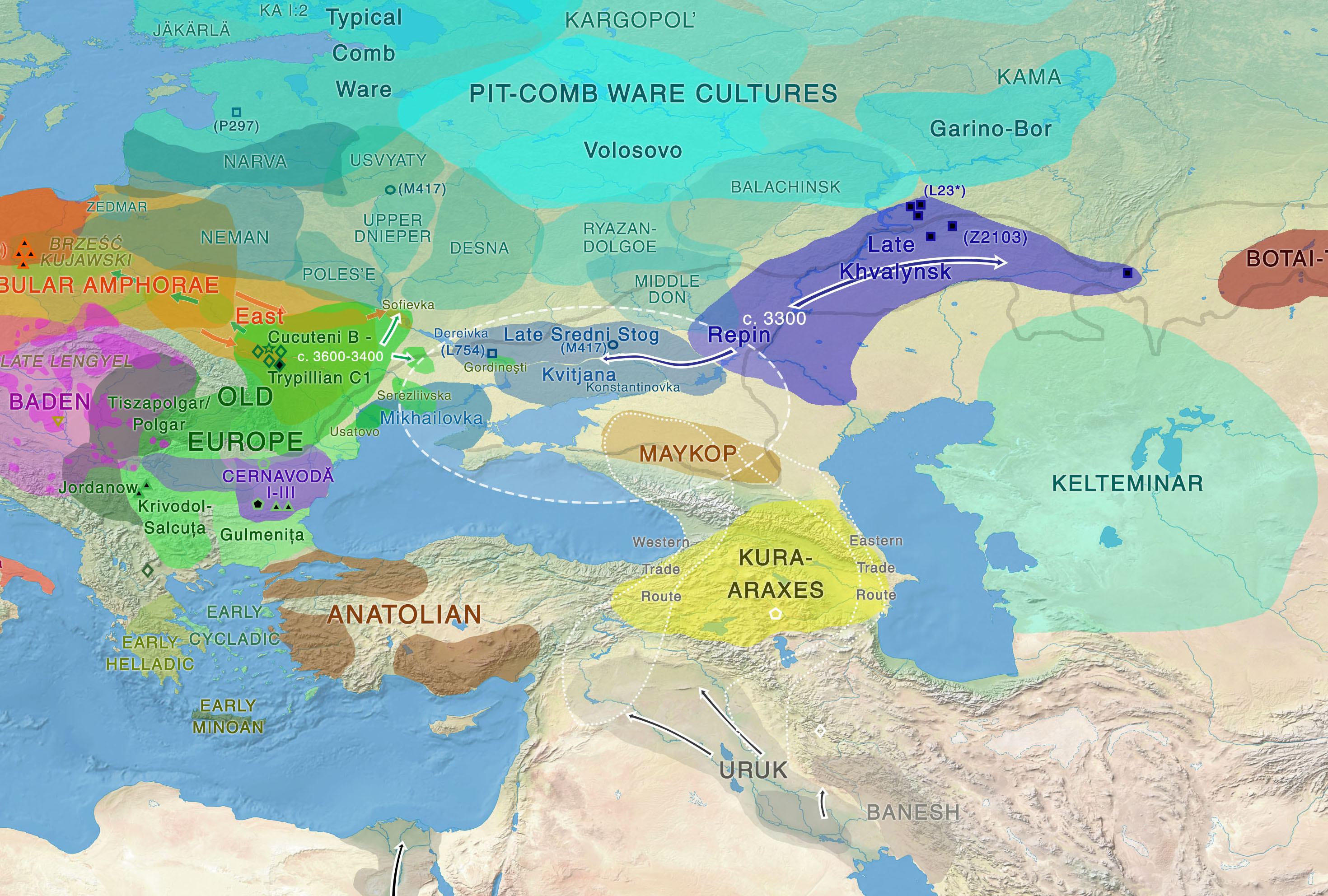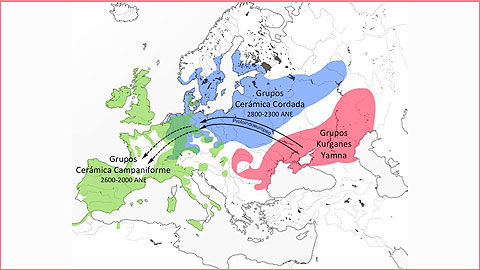I am not a fan of continuity theories – that much should be clear for anyone reading this blog. However, most of such proposals’ supremacist (or rather fear-of-inferiority) overtones don’t mean they have to be wrong. It just means that most of them, most of the time, most likely are.
While reading Tommenable’s comments, I thought about a potential alternative model, where one could a priori accept an identification of North Pontic cultures as ‘Indo-Slavonic’, which seems to be the Eastern European R1a continuist trend right now.
NOTE. To accept this model, one should first (not a posteriori) accept an Indo-Slavonic linguistic group on theoretical grounds, of course, and take the steppe ancestral component (and not archaeological data) as the most meaningful aspect to consider for language expansion and exchange (which we know is not the most intelligent approach to cultural or language change).
Thinking about how Genomics could challenge what mainstream Linguistics and Archaeology accepts, the only situation I can think of (using simplistic phylogeography) regarding late Khvalynsk-Sredni Stog contacts (until ca. 3300 BC) is:
- That the community of R1b-L51 lineages was in fact an isolated group , and not a western one – i.e. to the east within the Volga-Ural groups, or maybe to the south within the North Caucasian groups .
- That the R1b-Z2103 community was a huge one dominating over much of the steppe, from the Dnieper area to the Volga-Ural region (where we know they were).
- That R1a-M417 subclades (and especially subclade R1a-Z645) with steppe ancestry, as found in Corded Ware migrants,were only found in the North Pontic area (i.e. in Sredni Stog) during the fourth millennium (until at least 3300 BC, when Yamna substitutes it), and did not form other communities in the forest-steppe or Forest Zone (from where Corded Ware eventually expanded), as it is quite likely.
- That both the R1b-Z2103 and R1a-Z645 communities shared obvious genetic connections (whatever they were) around the Dnieper, that could justify a common, shared language.

Only then, if a widespread Graeco-Aryan-speaking community happened to be spread from west to east in the Pontic-Caspian steppe, with close contacts with North Pontic cultures, and having an isolated Northern Late PIE community somewhere different than West Yamna, it could leave for me a reasonable doubt of a cultural connection (maybe “Indo-Slavonic” in nature) of the North Pontic steppe. But then we would probably be stuck – yet again – with some sort of cultural diffusion event, impossible to demonstrate.
Since it is known (in Linguistics, and also in Y-DNA lineages, due to the early expansion of Z2103 subclades) that Graeco-Aryan groups separated early, this model would not be impossible.
Also a priori in favour of that model would be the early expansion of a (Northern IE-speaking) Pre-Tocharian population to the east. On the other hand, from an archaeological point of view, the group reaching Afanasevo seems to have expanded from Repin, just like the community expanding Yamna to the west of the Dnieper.
I really doubt there can be any serious discussion though, apart from amateur geneticists with a personal interest on this, because:
- Graeco-Aryan is a Late PIE dialect, and Late PIE guesstimates are more recent than that.
- Dialectal separation within a Late Proto-Indo-European language must have happened late, gradually, and in close contact, allowing for common innovations to spread through dialectal groups.
- It does not make sense in terms of prehistoric cultures, since there is no direct connection or migration among steppe cultures but for the Novodanilovka and the Yamna expansions.
- Indo-Slavonic is only supported by a handful of linguists, and not in the way or timing described in this model.
NOTE. You can read Kortlandt’s works in Academia.edu (also on his personal website) if you are really interested in knowing more about an Indo-Slavonic proposal, from an expert Balticist and Slavicist. However, if your intent is to demonstrate some ancient ethnic link of “your” people (whatever that means) to mythical Proto-Indo-Europeans, you would not need actual knowledge or sound theories to do that, so you can skip that part. Also, Kortlandt would probably support a later model of Indo-Slavonic expansion in the steppe, related to East Yamna, and later Sintashta, Srubna, etc…
- Although I am not an expert in Uralic languages, their spread over North-Eastern Europe during the Eneolithic and Chalcolithc was taken as granted by everyone before the realization that N1c lineages arrived quite late to the area.
- And, most importantly, this would be yet another ex novo proposal based solely on Genomics (i.e. without any linguist backing that up, not even Kortlandt, and only Kristiansen’s group in Archaeology), as geneticists usually do, that challenges every other data available. After the Yamna -> Corded Ware -> Bell Beaker migration model’s catastrophic failure, this new model will be very difficult to sell to the academic community…

If you think about it, if most modern Slavs were mainly of R1b-L23 lineages instead of R1a-Z645 (a replacement which, as it is clear know, is the consequence of a simple resurge of previous lineages in East-Central Europe, coupled with a later gradual replacement through founder effects, so no big migration history here), and Finnic speakers were mainly of R1a-Z645 lineages (whose replacement by N1c lineages seems also the consequence of quite late consecutive founder effects), I doubt we would be having this reticence to accept sound anthropological models.
So, we are speculating here for the sake of an unnecessary, naïve compromise…Just hoping to find some common ground to move on, now that the picture is clearer for everyone.
NOTE. The change of narratives where certain languages must have accompanied R1a-Z645 and N1c lineages, but in alternative ways not previously described, is obviously unjustified, if linguistic and archaeological data tell a different story. As unjustified as it is to change Yamna for “Neolithic Steppe” as homeland of Late Indo-European, to fit it with the steppe ancestry concept…
See also:
- The Indo-European demic diffusion model, and the “R1b – Indo-European” association
- Science and Archaeology (Humanities): collaboration or confrontation?
- Massive Migrations? The Impact of Recent aDNA Studies on our View of Third Millennium Europe
- The new “Indo-European Corded Ware Theory” of David Anthony
- Bell Beaker/early Late Neolithic (NOT Corded Ware/Battle Axe) identified as forming the Pre-Germanic community in Scandinavia
- The renewed ‘Kurgan model’ of Kristian Kristiansen and the Danish school: “The Indo-European Corded Ware Theory”
- Correlation does not mean causation: the damage of the ‘Yamnaya ancestral component’, and the ‘Future America’ hypothesis
- Something is very wrong with models based on the so-called ‘Yamnaya admixture’ – and archaeologists are catching up (II)
- New Ukraine Eneolithic sample from late Sredni Stog, near homeland of the Corded Ware culture
- Germanic–Balto-Slavic and Satem (‘Indo-Slavonic’) dialect revisionism by amateur geneticists, or why R1a lineages *must* have spoken Proto-Indo-European
- Heyd, Mallory, and Prescott were right about Bell Beakers